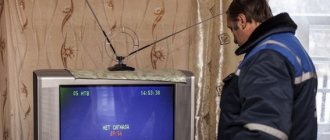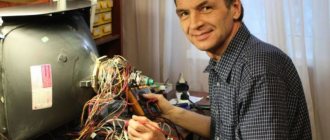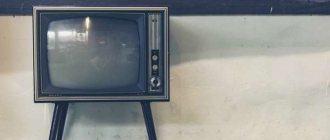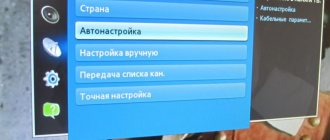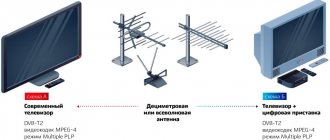Vladimir Kozmich Zvorykin was not an innovator in his field. Many before him tried to invent some semblance of devices that transmit sound and image. One of these inventors, Boris Lvovich Rosing, in 1907 developed a cathode ray tube that transmitted a signal and a receiver. Zvorykin became his student and went further - he invented television in the modern sense of the word and forever wrote himself into the history of television.
The inventor's childhood and adolescence
He was born into a very poor family. The father, a merchant of the first guild, a shipowner and grain merchant, had decent capital and was considered a wealthy man. He had his own shipping company and was also in the management of a public bank. Vladimir's mother, Elena Nikolaeva, ran a household and raised seven children.
Vladimir Zvorykin was born in 1889, on June 17, in the family estate in the city of Murom. He became the seventh and youngest child in the family. His father immediately placed his greatest hopes on him. Of all the sons of Kozma Alekseevich, he saw Vladimir as his successor and heir to the family capital.
Family of Vladimir Zvorykin
Girls at that time were not considered from this point of view, assigning them the role of future wives and mothers. And the other two sons - Nikolai and Konstantin - were not interested in family affairs. The eldest devoted himself to science, and the middle one, Konstantin, gave preference to metallurgy.
Therefore, all eyes were turned to Vladimir. His training and development were given great importance in order to entrust the management of his father’s affairs in the future. And he lived up to expectations - he grew up smart, attentive and efficient.
A craving for technology was revealed in him already during his studies at the Murom Real School. He repaired electrical wiring on his father's ships and was an excellent student. Therefore, it is logical that after graduating from college I entered the Technological Institute of St. Petersburg and graduated with honors.
Student at the St. Petersburg Technological Institute. 1906
But first there was admission to St. Petersburg University in 1906. Initially, Vladimir Zvorykin chose the Faculty of Physics. But after studying there for exactly a year, at the insistence of his father, he moved to the Technological Institute. It was here that a significant acquaintance with B. L. Rosing took place, a professor who would later play a huge role in his scientific work.
Zvorykin was accepted into the group of professors while still studying at the institute. In 1908, together with them, he visited England, France, and Germany, where students from Russia were introduced to the work of laboratories and industrial enterprises.
Beginning in 1910, he worked in the laboratory for 2 years under the leadership of Rosing. In 1912 he graduated from college and received the profession of industrial engineer. But the learning doesn't end there. In Paris, at the Collège France, he continues to get acquainted with technological processes, here Paul Langevin, a famous physicist, becomes his scientific supervisor.
In the laboratory of the Institute of Technology. 1910
Personal life and death of the father of television: perpetuation of memory
From early childhood, the life of Vladimir Kozmich was eventful and difficult. He traveled a lot around the world, visited many countries, and in his declining years he even managed to become disillusioned with his invention - television. In an interview, he frankly said that he had released “a monster capable of brainwashing all of humanity.” It was no longer possible to stop the running flywheel; the inventor had no control over it.
Wives and children
In his personal life, Zvorykin was no less “lucky” than in his work. He first married in nineteen sixteen, even before the October Revolution. His heart was captivated by a dental school graduate, Tanechka Vasilyeva, about whom little is known. Despite the fact that the marriage lasted fourteen years, it is difficult to call it happy. In the seventeenth, Tanya went to Berlin, from where Volodya took her to America only in the twentieth, and then he was constantly on the road. In 1930, he filed for divorce so that “a demanding family would not interfere with his research.” Tatyana gave birth to her wife two lovely daughters.
- Nina (1920).
- Elena (1927).
Vladimir was not destined to remain alone for the rest of his life, and the second love story in his life turned out to be much more romantic than the pragmatic first marriage. He met his second wife around the same time he divorced his first. Ekaterina Andreevna Polevitskaya was a professor of microbiology, and above all, she was “deeply” married. The husband resisted and did not give the woman a divorce for two decades, but he died in 1950, after which Vladimir Kozmich decided to get married without delay. It is clear that at that age the couple never had children.
Death and memory of the creator of television
Having lived a long and eventful life, Vladimir Zvorykin, the inventor of television, the electron microscope and many other devices, died on July twenty-ninth, nineteen eighty-two. He was fully ninety-two years old, but until the last moment he remained of sound mind and solid memory, wrote scientific works, articles in magazines and simply memoirs. It is believed that his ashes were scattered over the American lake Taunton lake, not far from his country house. How true this is is not known for certain, but there is no reason not to believe this version.
There are five known books written by Vladimir Kozmich, published during the period from thirty-six to fifty-eight. In two thousand and thirteen, a monument was erected to him on the Ostankino pond in Moscow, and a little later another monument was erected in the inventor’s homeland in Murom. There is a memorial plaque on the building of the real school from which he graduated, and a street in the town of Gusev is named after him. In two thousand and ten, a documentary film about this great man called “Zvorykin-Muromets” was released, directed by Russian researcher, actor, TV presenter and journalist Leonid Gennadievich Parfenov.
Military service
All plans were disrupted by the First World War. Research activities and scientific activities have to be suspended - Vladimir returns to Russia to serve in the army.
First, Zvorykin served in Grodno, in the telegraph unit, then moved to Petrograd. Here he is given the rank of officer - he works at the officer's electrical engineering school.
Vladimir Zvorykin during his military service
Vladimir's passion for radio engineering once played a cruel joke on him. While serving in the officer's radio school, he almost went to trial. One of his colleagues saw how Zvorykin carried out his experiments - he asked his subordinates to speak into “some kind of box with a hole.” Due to the fact that the members of the commission that met about the emergency were knowledgeable about radio engineering, Vladimir was released, but experiments with juniors were forbidden.
During the First World War, Vladimir Zvorykin meets Tatyana Vasilyeva, a student at the dental school. In 1915 they arrange a modest wedding. But family life lasts only 3 years - in 1918 Tatyana leaves for Berlin to emigrate, but he himself refuses to move and remains in Russia.
With his wife Tatyana and daughter Nina
At the same time, he was appointed military chairman of the ROBTiT plant, which at that time worked for the benefit of the army, aviation and navy - producing wireless radio stations. Here Vladimir meets the famous scientist S.M. Aizenstein, who played a significant role in the fate of the future inventor.
The revolution that took place in February 1917 greatly changed Vladimir's plans. Since he did not join the army and did not appear at the conscription office, a warrant was issued for his arrest. In order not to expose himself to danger, he hastily leaves Moscow, gets to Perm through Nizhny Novgorod, heading to Omsk. In Yekaterinburg he is arrested, but at this time Czechoslovak troops enter the city and free him.
Zvorykin is sent on a business trip to the USA, but leaving Omsk is possible only through the north by water. As part of a scientific expedition, he travels by boat for more than a month, first to Arkhangelsk, then through Norway, England to the USA. He arrives at his destination only at the end of 1919. He returns back through Japan, then from Vladivostok to Omsk - almost a round-the-world trip!
Television in other areas of life
Throughout his career, V.K. Zvorykin showed himself as a versatile scientist: in the 1940s he developed an electron microscope, and during the Second World War he actively worked on the invention of devices for combat and reconnaissance at night, as well as air bombs guided by a television screen (TGM - Television Guidance Missile).
In the peaceful post-war years, the inventor’s sphere of scientific interests also became peaceful. He took up developments in the field of medicine. In particular, the principles of television were used in the development of medical electronics.
Emigration to the USA
Upon returning to Russia, he receives a new assignment, also related to a trip to the USA. Having successfully reached the States, Zvorykin remains here forever. At first, B. A. Bakhmetyev, the Russian ambassador, helps him in New York.
At first, Zworykin had a hard time in America. He practically did not speak English, had no recommendations, and in his homeland he did not distinguish himself enough to gain fame in distant countries.
In the meantime, the Provisional Government was liquidated in Russia, but the power of the Bolsheviks in the United States is still not recognized. Thanks to Bakhmetyev, who at this time heads the procurement commission, Vladimir is added to the staff. His main task is to maintain accounting records, send out letters offering services, and he is also involved in radio electronics.
After some time, a response comes from, in which he is offered a job in one of the research laboratories in Pittsburgh, where he moves. The salary here is half that of the purchasing commission, but the desire to develop in his specialty is so great that Zvorykin turns a blind eye to these small details.
In the laboratory
Of course, it is not possible to immediately implement ideas for creating television transmitting devices in the Westinghouse laboratory. For the first year, Vladimir has been working on improving the technology for the production of receiving and amplifying lamps. Seeing that he won’t be able to do his own research here, he soon moves to a less well-known company, but with a higher salary. However, in 1923, he returned to Westinghouse again, but with the condition that he could realize his idea of creating electronic television.
Capture of the Azov fortress
Discussion: 4 comments
- Svetlana:
08/03/2008 at 00:00Long live the Russian people!
- Dimitri:
07/28/2011 at 00:00
Glory to our God and glory to the Russian people!
- Kind:
01/29/2012 at 00:00
Is he actually Russian?
- Alexander:
08/01/2016 at 00:00
My fellow countryman, from Murom.
Icon stop: where did the invention of television begin?
Several months pass in intense work. Zvorykin manufactures a fully electronic television system, which is a transmitting tube. It was patented at the end of 1938, patent number 2141059 was issued for it.
Zvorykin’s brainchild differs from other, earlier inventions in the implementation of the principle of accumulation of charges that are received by black point photocells. This increases the device's sensitivity to light. The scientist himself called it “iconoscope”. But it has nothing to do with icons and religion in general - the name was derived from Greek words that literally mean “to see an image.”
“Iconoscope” in the hands of the inventor
Of course, with the modern level of television, the invention of that time seemed like a children's toy - the image was of very low quality. But, most importantly, Zworykin discovered a fundamentally new opportunity to transmit a signal in a completely different way, which no one had been able to do before.
He perfected his development for a long time - it went through several stages from the first sample of an iconoscope to the modern kinescope. Along the way, some technological problems were solved, for example, the photosensitivity of the structure was increased.
After modifications, Vladimir Zvorykin demonstrated his invention to Westinghouse management. However, the general director of the company did not appreciate it and ordered all work in this area to be stopped, and he himself to “do useful work.”
The subsequent development of photocells, which were used for the equipment of sound cinema that was then gaining momentum, brought Zvorykin fame throughout the state and especially in Pittsburgh. Local newspapers wrote a lot about him, and in one of them he was featured on the main page.
While busy with instructions from management, Vladimir did not abandon the idea of finally creating a device that would be suitable for practical use in the system he created for television broadcasting. During his research, he also took into account the commercial component of the campaign - his goal was to create a device that would be actively purchased and that could generate income.
First attempt at television broadcasting
At this stage, he began to think hard about investing. He needed a businessman-investor who would believe in his development and support him financially. He became David Sarnov, a Russian emigrant, president of RCA (Radio Industrial Corporation of America).
For Zvorykin, he became a kind of locomotive. Having provided him with all his connections, funds, and technical capabilities, he directed his abilities to create means for television broadcasting that could be useful to a mass audience.
The final version of the transmission tube was created in 1931. It was she who became the prototype of the future television broadcasting system. Practical testing was carried out in Camden. In 1932, a station with a power of 2.5 kW was installed on the tallest building in New York at that time, the Empire State Building.
Diagram of Zvorykin's first television tube with a one-sided target. Patent application. 1931
The television broadcast was successful, so almost immediately RCA factories began producing televisions equipped with a kinescope designed by Vladimir. The first subscribers are residents within a radius of about 100 kilometers near the transmitting station.
Of course, today in the television broadcasting system no one uses the iconostope developed by the scientist. It was later superseded by the more modern device, the orthicon, which was replaced by the superorthicon. But without Zvorykin’s developments they would not have seen the light of day. And the modern television tube (kinescope) is, in fact, a device invented by Vladimir, only more modern.
Years of World War II
By the mid-30s of the last century, it became clear that the world would inevitably face war. All thoughts of the United States leadership were focused on expanding the army, so television was temporarily forgotten. But Zvorykin himself did not forget. Postponing the implementation of his ideas “for later,” he develops the world’s first night vision device, which immediately finds application for military purposes. The scientist also creates a controlled aerial bomb equipped with an icon stop - during the flight, the video is broadcast to a device behind which the operator sits.
For those years it was a real breakthrough. Such innovative technologies applied in the military sphere have allowed the United States to gain several advantages. It became clear that the scientist’s developments could be useful in various fields.
All the years of his life in the USA, Zvorykin did not lose touch with his homeland and did not give up the thought of ever visiting the Soviet Union, especially visiting the city of his childhood. Over time, the Bolsheviks turned a blind eye to the fact that Vladimir fled to America and collaborated with the “whites”.
And as soon as industrialization begins to take its first steps in the USSR, the country’s leadership remembers physics and its developments. RCA enters into an agreement with the People's Commissariat of Electrical Industry, at the same time raising prices for its products. Thanks to this, the first Soviet-made television, “VK,” was based precisely on Zvorykin’s developments. And already in 1938, the first transmitting station was built in the capital.
Throughout World War II, Zworykin was involved in military technology. For this he was awarded the rank of colonel in the American army. In addition to the night vision device, he developed and implemented illumination for cars, infrared sights, missile tele-guidance systems and much more.
Vladimir Zvorykin (center) celebrating his 50th birthday at his country house in Taunton Lakes. 1939
At the same time, Zvorykin is working on medical technologies. He is the author of an electron scanning microscope - the first in the world that allows you to see not only the inside of an object, but also examine its surface in detail. After the war, in the fifties, he created an endoradiosounding device - a small capsule that, after swallowing, passes through the digestive tract and allows the doctor to accurately diagnose and the patient to experience less discomfort.
V. Zworykin and J. Hillier with one of the first electron microscope designs. Princeton, 1942
The name of the outstanding Russian engineer-inventor Vladimir Zvorykin, who lived most of his life in the USA, is now often mentioned in the domestic media. His name comes to mind whenever there is talk about the need for technological innovation in Russia.
The name Zvorykin became one of the successful symbols of new landmarks. It sounds logical and fair from the lips of the country's leadership in connection with the establishment of the annual Zvorykin Prize - the National Prize in the field of innovation. A little later, the feeds of news agencies bring news of the creation by Leonid Parfenov of a historical documentary film entitled “Zvorykin - Muromets”, as well as of an all-Russian fundraiser for the installation of a monument to the “father of television” in his native Murom.
In the Russian diaspora, Vladimir Zvorykin is a special source of pride: he is the first member of the Russian-American Chamber of Fame. It was Vladimir Kozmich Zvorykin who was awarded the title of Honored Russian American in 1978 by the Congress of Russian Americans for his outstanding contribution to world science and technology. It should be noted that in the USA the name of Zvorykin is highly revered, especially by scientists. The famous television historian Albert Abramson dedicated a solid monograph to him, published in 1995, “Zvorykin. Pioneer of television." (The author met with Vladimir Zvorykin during his lifetime, and he gave him one of the versions of a detailed autobiography.)
Although a little earlier he explained the need to promote Zvorykin as the image of the son of a merchant from Murom, who invented television, as a correct role model, in general Surkov noted the low demand for innovation among companies and the lack of habit of people being closely interested in the material world. Surkov considers Russians (including himself) to be more “holistic,” that is, an integral type of personality. However, if there is nothing new in this, then in another statement of Surkov there is: we do not have the habit of migration and tolerance towards eccentrics, while in America they have learned to appreciate the ability of people to think differently, since they are the ones who often invent what something new. And it’s okay if somewhere in Skolkovo an artist lies on the lawn, Surkov noted dreamily, and everyone internally agreed with him too.
The Kremlin is looking for like-minded people
“A gift to the American continent,” one of his colleagues in the field of electronics described Vladimir Kozmich Zvorykin. Having every reason for this: it was Zvorykin who invented the twentieth century - electronic television; his innovative ideas were also used in the creation of electron microscopes, photomultipliers and electron-optical converters, in the creation of new models of military equipment, engineering and medical equipment.
...Vladimir Kozmich Zvorykin was born on July 17 (29th New Style) 1889 in the family of the merchant of the first guild Kozma Zvorykin, who traded bread, owned steamships and was the former chairman of the Murom Public Bank. The three-story Zvorykinsky stone house has survived to this day and now serves as the Murom Historical and Art Museum. In his autobiography, the famous scientist and inventor characterizes his father as a man of progressive ideas, who was also the head of Murom for one term. In addition to Vladimir, the youngest child, the family had one more brother and five sisters. From childhood, the father tried to accustom his children to socially useful work, writes Zvorykin. He himself, according to him, showed an interest in technology from his youth. After graduating from the Murom Real School, in 1906 he entered the St. Petersburg Institute of Technology. Takes part in student unrest. Moreover, having been captured while distributing leaflets calling for democratic reforms and elections to the Second Duma, he spends two weeks in prison with his student friends. The time of student for the future engineering genius is also significant for the fateful meeting with Professor Boris Rosing, the author of pioneering works on electronic image transmission at a distance. The young engineer begins to devote a lot of attention to his work as Rosing's assistant in a special laboratory. In addition to Rosing’s scientific ideas, the autobiography tells, the student Zvorykin was greatly impressed by his foreign trip to industrial plants in Germany, Belgium, France and England, which took place under the auspices of the International Chamber of Commerce.
Having received a diploma in electrical engineering in 1912, Zvorykin went to study at the Paris College de France with the outstanding physicist Paul Langevin. Then, despite his father’s absentee attempts to involve his son in the common Murom cause, he continued his studies at the University of Berlin. Shortly after returning to Russia via Denmark and Finland during World War I, Zvorykin was drafted into the army. For a year and a half in Grodno, he was responsible for setting up and equipping radio stations. Meets the February Revolution in Petrograd with the rank of lieutenant, working as a teacher at an officer radio school. After the revolution, his father’s business and the magnificent family house above the Oka River in Murom “become the property of the victorious proletariat.” Established scientific and industrial ties have been destroyed.
“It became obvious,” wrote Zvorykin, “that a return to normal conditions, in particular for research work, could not be expected in the near future. The new government issued strict decrees, according to which all former officers were obliged to report to the commissariat for conscription into the Red Army. I didn't want to participate in the civil war. Moreover, I dreamed of working in a laboratory to realize the ideas I had in mind. In the end, I came to the conclusion that for such work you need to go to another country, and America seemed to me to be such a country.”
The talented young man recalls that he “had friends in a large cooperative organization that had its representative offices in America and the Siberian city of Omsk.” He managed to receive an invitation from these friends to go there to carry out an official assignment. Having stocked up with a lot of official papers, he goes to Siberia. Wandering around the former empire (by train to Nizhny Novgorod, then along the Kama by steamship to Perm, from there again by train to Yekaterinburg and again by train to Omsk), the young man eventually arrives at a meeting with representatives of the provisional Siberian government, which is not associated with cooperation with the Bolsheviks. This government sends him to the United States to negotiate the supply of radio equipment. Since Omsk was cut off on all sides except the north by the warring factions, Zvorykin joins the Arctic expedition and floats across the Kara Sea by steamer over the course of a half-month along the Irtysh and Ob rivers to the island of Vaygach. At the end of the journey he reaches a radio station located between the islands of Vaygach and Novaya Zemlya and built to report on ice conditions in this part of the ocean. After waiting for the icebreaker, a few weeks later Zvorykin reaches Arkhangelsk, occupied by Entente troops. Having received visas and made stops along the way in Norway, Denmark and England, on the eve of 1919 he finally arrived in the United States.
“Soon after arriving, I found the office of a cooperative organization, to which I owed a business trip and a trip,” the researcher recalls. There, a young engineer is studying radio equipment. But “in the spring, an order was received from the Siberian government for me to return to Omsk. They needed a radio specialist, and I also had to bring some radio equipment parts.” And he goes back. The main map of its route is as follows: Seattle - Yokohama - Vladivostok. And in January 1919, Zvorykin symbolically completed his trip around the world, returning to Omsk, this time through the Pacific Ocean, Japan, Vladivostok and Harbin. An adventure that seemed so incredible that initially Albert Abramson, the biographer of the outstanding inventor, did not believe in the authenticity of Zvorykin’s story.
After some time, Zvorykin - already during the reign of Admiral Kolchak - went to the USA again. This time free from obligations to anyone. Forever. He arrives without recommendations, and, moreover, speaks virtually no English. As a message from his homeland, he brings with him a jar of myrrh, a blessed oil used in church services, which the Russian Orthodox Church asked to be given to the head of the Russian Church in the USA.
The future world genius was lucky: sensing his potential, Zvorykin was initially taken under the wing of the Russian Ambassador to the USA B.A. Bakhmetyev. (The fate of Bakhmetyev himself is noteworthy: the United States is in no hurry to recognize the Bolshevik government, even though the Provisional Government in Russia has long been liquidated. And a former professor at the St. Petersburg Polytechnic Institute, Bakhmetyev still manages the activities of the embassy, information bureau and purchasing commission of Russia in the United States.) Zvorykin is enlisted on the staff of the purchasing commission based in New York. In his autobiography, the manuscript of which is kept in the Pittsburgh Museum, you can read: “... Worked as an accountant.”
.
The newly minted emigrant persistently sends dozens of letters to various companies offering his services as a radio electronics specialist. As a result, he is invited to work at a research laboratory (Pittsburgh, Pennsylvania). (A large group of emigrants from the former Russian Empire worked at this company. In particular, Stepan Timoshenko, a specialist in the strength of materials, whose books have been translated into many languages.) The young radio engineer’s desire to work in his specialty is so great that, according to historians, he was not I was confused by the size of the salary, half that of the procurement commission. Zvorykin did not immediately have the opportunity to study television in the Pittsburgh laboratory. He worked fanatically: the Westinghouse security guards were ordered by management to send the scientist home if the windows of his laboratory were lit after 2 am.
In 1923, Zvorykin finally got the opportunity to begin implementing the idea of creating electronic television. And in the same year, he drew up a patent application in which he fully described the electronic television system. The US Patent Office refused Zworykin on the grounds that the photosensitive plate for the transmitting tube (that is, a television camera) described in the application does not exist in reality and there are serious doubts about the possibility of its creation under existing conditions. Then he takes a time out and completely switches to the official task of Westinghouse - the development of photovoltaic cells, which have begun to be actively introduced in engineering and industrial construction. It was this, as he himself admitted, uninteresting work that made his name known both in Pittsburgh itself (in 1926 the University of Pittsburgh awarded him a doctorate) and beyond.
At the same time, the inventor did not stop doing his work related to television.
“By that time,” he later recalled, “I realized that work on an idea that could lead to commercial success must be camouflaged until the possibility of making a profit became obvious to business people.” In order to move from experiments to pilot production, a representative of large business was needed.
And such a representative appeared in the person of compatriot David Sarnov, president of Radio Corporation of America (RCA). Sarnov was born into a poor Jewish family in the town of Uzlyany (modern Belarus) and was brought to the United States by his parents at the age of nine. David Abramovich spoke both Russian and English perfectly; was a completely assimilated American. Behind Sarnov is the path from an ordinary employee of the Marcorni company to the head of a huge corporation.
After talking with Zworykin, he, unlike other American bosses, believed in his ideas and became his boss and patron for many years. Sarnov subsequently recalled that in response to a question about the estimated cost of the project, Zvorykin asked for a “modest” $100,000. In fact, the design work cost a hundred times that amount, and the company began to receive its first income from television when the total investment exceeded $50 million. In 1929, Zvorykin began working at the RCA branch located in Camden (New Jersey). In 1931, he created the final design of the transmitting tube iconoscope, which became the basis for the future electronic television system. After a series of practical tests carried out in Camden, a 2.5 kW television transmitting station is installed on the tallest building in New York - the Empire State Building. RCA factories begin to produce televisions with a picture tube designed by Zvorykin. Residents of New York and surrounding areas within a radius of up to 100 km are becoming the first subscribers to electronic television. By 1933, Zvorykin and his employees completed the creation of an electronic television system. The birth of the television can be dated back to 1933, when Vladimir Zvorykin spoke at the annual conference of the American Society of Radio Engineers. In his report “Iconoscope - a modern version of the electric eye,” the scientist summed up the results of many years of work. He invented a device capable of transmitting the resulting image of an object to the screen of a cathode ray tube, that is, a kinescope. The new development became one of the most outstanding inventions of its time and is deservedly called the “miracle of the twentieth century.”
For the sake of objectivity, we note that not only Zvorykin claimed the title of inventor of television. In the late twenties, yesterday's schoolboy Philo Farnsworth, a self-taught person from Idaho, who, with the support of philanthropists Leslie Gorell and George Everson, founded his own laboratory in San Francisco, is developing a system for transmitting signals at a distance. Farnsworth’s contribution to the creation of electronic TV is “weighty and undeniable,” writes the modern Russian magazine Popular Mechanics. But the Image Dissector of the 1928 model, developed by him, was of little use for creating television equipment. Zworykin managed to do what Philo Farnsworth and his equally talented like-minded friend and competitor, Hungarian Kalman Tihanyi, who filed an application for his invention with the US Patent Office in 1928, failed.
All issues related to the recognition of the priority and authorship of Vladimir Zvorykin are described in detail in the book by television history researcher Albert Abramson. It also says that RCA President David Sarnov, in order to avoid conflicts in this matter and guided by commercial interests, bought his patents from Farnsworth for $1 million. He also acquired the patent of the Hungarian inventor.
In the second half of the 1930s, the threat of war became increasingly obvious. Many leading American corporations receive military orders. During these years, Zvorykin was mainly engaged in the problems of electronic optics, working together with I. Langmuir, J. Morton, L. Malter... Research in the field of electron-optical transformations led to the creation of a night vision device operating in the infrared range. During World War II, night vision devices designed by Zvorykin were used by the US Army to equip tanks and vehicles, and also as sights. It was he who developed the first television-controlled aerial bomb, which had an iconoscope that transmitted a picture to the operator. A little later, it was his laboratory that prepared a night vision device, which was immediately adopted by snipers, tank crews and operators. Albert Abramson, in his voluminous study, writes a lot about guided missiles and underwater torpedoes, developed with the active participation of Vladimir Zvorykin. The list of applications of inventions can be continued endlessly.
Years of living in the USA did not alleviate the homesickness. Vladimir Zvorykin strives to go to Russia. For the management of the RCA company, Zvorykin’s trip to the USSR is seen as an opportunity to receive Russian orders for its products: the United States was experiencing a severe economic crisis - receiving orders for products from other countries was welcomed. Zvorykin himself dreamed of meeting his sisters and brother. A few months before his first trip to the Soviet Union, representatives of the Soviet Union, specialists in the field of radio electronics S.A., visited the company on an official visit. Vekshinsky and A.F. Shorin. In a private conversation, the famous engineer was assured that the Soviet government would “provide him with the most favorable conditions for work and life and guarantee protection from any persecution related to his pre-revolutionary past.”
In August 1933, Zvorykin was in Russia. The report “Television using cathode tubes” in the hall of the Leningrad NTO for Electricians gathers a huge number of specialists. A year later, Zvorykin goes to Russia again. In 1935, RCA concluded a solid agreement with the People's Commissariat of Electrical Industry of the USSR, according to which the Soviet state was supplied with “technological documentation and materials, equipment for the production of electrovacuum devices, equipment for equipping the first Soviet electronic television center, etc.”
In the USSR, Vladimir Zvorykin always received a warm welcome. “Bolsheviks,” writes V.P. Borisov, “they forgave the talented scientist everything: his officer’s shoulder straps, his collaboration with Kolchak, and his flight to the USA...” Stalin’s USSR began industrialization: here they were purposefully interested in acquiring the latest technologies, including the purchase of television equipment. Moreover, the inventor is honored with a reception from the People's Commissar of Communications of the USSR Rykov.
The first Soviet TV “VK” was created precisely according to Zvorykin’s developments. By the end of 1936, the Leningrad Institute of Telemechanics, which by that time had been transformed into the All-Russian Research Institute of Television, completed the development of an electronic television system. On March 10, 1939, regular television broadcasts began from the Moscow Television Center on Shabolovka, and in 1954, serial production of television receivers was launched at the Kuntsevo Radio Engineering Plant in Moscow.
...The famous inventor was able to visit his homeland again only in 1959.
In 1945, he was actually banned from traveling abroad and was denied a passport. Until the end of the 50s, Zvorykin did not travel. One of the chapters of Albert Abramson's monograph contains detailed information about how the FBI was actively interested in Zworykin since 1943. Why from this moment? In 1943, Zvorykin, who by that time had moved with his laboratory to the most prestigious city from a scientific point of view, Princeton, was approached by activists of the Fund for Relief of War Victims in Russia, which was involved in raising funds for the purchase and sending of food and clothing to the population of the USSR, offering to head the New York branch of this fund. Zvorykin, who in principle had not previously affiliated himself with any parties or movements and was not involved in any social activities, agreed this time. The American Fund for Relief to Victims of the War in Russia, as it became known later, was one of the first on the FBI's list of suspicious organizations and was repeatedly searched at its own headquarters. At the same time, Vladimir Zvorykin in 1943 agreed to head the list of leaders of the New York Science Committee of the Council of American-Soviet Friendship.
Close attention to the life of the famous scientist, a native of Russia, in addition to his social activities, is undoubtedly connected with his growing position in American society. On October 26, 1944, the headquarters of the US Air Force appointed Zvorykin as an expert consultant to the Air Force on scientific issues. Zworykin's laboratory at RCA developed several major military television systems during the war. Zvorykin’s contribution to the technical equipment of the US Army is invaluable.
Albert Abramson's book provides data on the persecution of the inventor and surveillance of him by FBI agents and informants. The author emphasizes that this section of the study was written on the basis of FBI documents, which he used thanks to the famous Freedom of Information Act adopted in 1966. True, most of the information received at his request was obscured, as is customary in cases of special secrecy information. Nevertheless, the chapter of the book devoted to the activities of the inventor during World War II is densely saturated with references to his dossier compiled by the FBI. For example, FBI files contain information that Vladimir Zvorykin, as a member of the science committee of the National Council of American-Soviet Friendship, asked one of his colleagues at the University of Berkeley (California) to provide a list of scientific literature for Russian scientists. FBI files dating back to August 1944 contain information about Zworykin's property. Information from an informant dated November 18, 1944 indicates that Zvorykin discussed with American colleagues the possibility of creating an atomic bomb. The documents, dated November 30, 1944, report that Senator McKee requests that Zworykin's name be added to a special national censorship list in order to send copies of all his correspondence (both internal and external) to a special bureau. Since December 8, 1944, Zvorykin’s telephone in his Princeton apartment has been wiretapped. The telephone in the country house was also wiretapped. His meetings with Ekaterina Polevitskaya, who later became his wife, also came under surveillance.
The materials published in Abramson's book, in particular, indicate that on February 19, 1945, after pressure from David Sarnov, the head of the FBI, John Edgar Hoover, was forced to write a letter in which he said that Zvorykin had nothing to do with the construction of the atomic bomb. It would seem that this should have ended the FBI's pressure, but it did not end.
In 1945, groups of specialists were formed in the United States to travel through the territory of Germany that had just been occupied by the Allied troops. The goal was to “identify the importance of extant research and industrial developments, identify highly qualified scientists and engineers, etc.” for the purpose of using them in the interests of the United States. Zvorykin, who arrived at Washington airport on April 26, 1945 and was leaving as part of a delegation to Germany, was categorically told that “he was not allowed to leave the United States.”
Vladimir Zvorykin continues to be showered with signs of recognition from the United States: he was awarded a medal. Howard Potts, an Honorary Diploma from the President of the United States, the Lamme Medal and Prize of the Institute of Electrical Engineers, the Pour Richard Club Gold Medal for outstanding achievements in science, etc. However, the inventor fears for himself, because he believes, as his biographers note, that “scientific merit is weak protection in an atmosphere of pseudo-patriotic frenzy.”
In 1951, a significant event took place in Zvorykin’s personal life. After many years of bachelorhood, he marries Ekaterina Polevitskaya, an emigrant from Russia. The history of their union is significant - they met twenty years before the wedding. Zvorykin was fascinated by the beauty and charm of Polevitskaya, who was married. The marriage proposal followed when Zvorykin learned that Ekaterina Polevitskaya had become a widow. And although both newlyweds had crossed the sixty-year mark by that time, they lived in love and harmony for more than thirty (!) years. His energetic and erudite wife, a doctor by profession, greatly influenced the determination of Zvorykin’s future professional interests. After retiring as director of the RCA Electronics Laboratory in 1954 at the age of 65, his scientific and inventive interests shifted primarily to the field of medical electronics.
Zvorykin’s merits are appreciated so highly that he is awarded the position of honorary vice president of RCA. “The concept of resignation has nothing to do with Vladimir Zvorykin,” Sarnov said in his closing speech at a Princeton University conference specially organized in honor of the outstanding inventor. — A scientist like Zvorykin never resigns. His talent never fades. The imagination and creative instinct of a true scientist lead him to even more extensive knowledge.” That same year, Zworykin began work as director of the Center for Medical Electronics at the Rockefeller Institute in New York. To study chemical reactions inside living cells, the talented inventor soon created a unique microscope that reproduces a color image of objects on a television screen. The further development of integrated microelectronics allowed the scientist to implement the idea of endoradiosounding together with doctors. The probe in this method is a miniature radio transmitter tablet, with the help of which “you can obtain data on acidity and other indicators of the internal environment.”
Together with the outstanding mathematician J. von Neumann, Zworykin is developing a new method for forecasting weather changes using weather rockets and computer data processing. Then he takes on the problem of improving traffic safety on expressways and, as a result, creates an experimental model of a radio-controlled safe car. It is significant that in 1954, our eminent compatriot accurately predicted that a person would see the surface of the Moon and other planets precisely with the help of a television, which would be delivered there on board an interplanetary spacecraft.
In addition to working at the Rockefeller Institute, the scientist and inventor begins teaching as a visiting professor at the University of Miami. The International Federation of Medical Electronics and Biological Technology is created, Vladimir Zvorykin is elected president of the federation.
In 1938, the famous aircraft designer Sikorsky was entrusted with giving a speech to his compatriots on the occasion of the 950th anniversary of the Baptism of Rus'. Referring to Fyodor Dostoevsky and Vladimir Solovyov, their no less famous compatriot admonished: “The Russian people should not think about how to turn back to what did not stand, apparently was not saved, but think about how to get out of that swamp, in which we are now stuck, get out onto the broad road to move forward.”
The real Ilya Muromets
All these years, Vladimir Kozmich carried in his heart love for Russia and his native Murom. In 1967, the Zvorykin couple formalized an Intourist visit to Vladimir. The two of us went to admire the cathedrals. Then, having caught a taxi, we drove to the closed city of Murom. Thanks to his courage, fifty years later Vladimir Zvorykin is again in his hometown near the house where he spent his childhood and adolescence.
Vladimir Kozmich Zvorykin is the holder of 120 patents, co-author of the books: Television: The Electronics of image transmission (1940, 1954), Electron optics and the electron microscope (1945), Photo electricity and its applications (1949), Television in science and industry (1958 ). Author of 100 technical articles in professional publications. Member of the National Academy of Sciences, Academy of Engineering, National Chamber of Honor of Inventors of the USA. In 1966 he was awarded the National Medal of Science by US President Lyndon Johnson.
About the death of V.K. Zvorykin in 1983 was reported by all US newspapers.
SEND:
| Follow @chaskor |
Related articles:
- Heat, economics, innovation. Development of a mechanism for increasing the efficiency of the functioning of heat supply systems of enterprises.
- Schneider Electric study. How Russian companies are changing their approach to sustainable development.
- “They are trying to tell our farmer about IoT, but he, poor thing, is spinning like a squirrel in a wheel.” How to use new technologies in agriculture.
- “We are missing two dozen great innovations.” Bill Gates warns: climate change is a more complex problem than a pandemic.
- How digital helps take care of the environment. Trees, innovation and activism.
- Medicine in full. How virtual reality saves people.
- What do we expect from the medicine of the future? Prevention, gadgets, technology.
- About it. How they started talking about sex on Russian TV. And why nothing came of it.
- Innovative invites you to the second annual conference “Job and The City”.
- Monologue with a noose around the neck.



